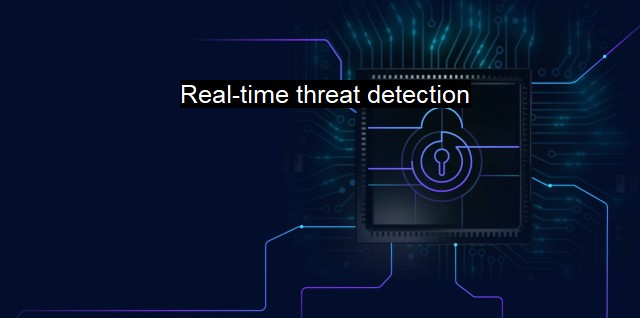What is Real-time threat detection?
Protecting Against Cyber Attacks with Real-Time Threat Detection: The Vital Component of Modern Cybersecurity
Real-time threat detection is a sophisticated cybersecurity function commonly used in modern antivirus systems to protect digital property from potential threats. It provides immediate identification, detection, and response to probable cyber threats as they occur, before they can compromise security or damage systems. Detecting such real-time threats requires continuous monitoring, efficient identification, and rapid response to disparate patterns of security threats. It comprises numerous security technologies, tools, and tactics to safeguard data, applications, systems, networks, and other digital infrastructure.Cyber-attacks have become a regular occurrence given the rise of interconnectivity and omnipresent digital landscapes, which invariably demand dynamic cyber defense mechanisms. Herein, real-time threat detection is effective because it doesn't allow the threat to infiltrate or reside in systems. The instant detection earmarks threats promptly, taking appropriate action on potential threats before they can culminate into cyber breaches. Significantly, it negates the requirement of routine scans and manual updates needed in traditional antivirus mechanisms, allowing an automated parallel check of threats to safeguard assets.
For effective real-time threat detection, vigilant and constant monitoring of cyber traffic is pivotal in a secure system. This includes the monitoring of data transactions and communications among devices connected to a network, not restricted to outgoing and incoming interchanges but extends to inter-communication among devices within the network. By monitoring each behavior and transaction, unusual and suspicious activities get caught in the initial stage, triggering automated alerts to respond to this anomaly swiftly.
Various mechanisms tap into real-time threat detection; one crucial utility is heuristic detection. It doesn’t rely on known signatures or fixed conditions of threats but observes unpredictable behavior patterns, enabling the detection of new and covert threats. Another effective technique is behavior-based detection, which focuses on monitoring a system for disorderly behavior. It lays out normal behavior patterns for system processes and flags any instance that shows alteration, circumventing intrusion threats.
There is sandboxing; a method where suspicious programs are isolated and observed in a controlled environment to monitor behaviors. There is also machine learning, an advanced technology that automatically learns from and adapts to changes in cyber threats; artificial intelligence which analyses large amounts of data, seeking patterns helpful in detecting threats, and many such innovative processes intertwined at different layers for comprehensive real-time threat detection.
Factor in the growing menace of advanced persistent threats (APTs), wherein a cybercriminal persists in a network unnoticed, spreading malware or stealing data slowly over a long period. Real-time threat detection proves efficient in identifying potential APTs, enhancing preventive mechanisms that restrict intrusions in early stages.
Another benefit of real-time threat detection is the swiftness of response times. Once the threat is detected, automated or semi-automated responses activate promptly, putting brakes on threat proliferation. This dynamic response reduces damage to the user's data, applications, systems, or networks by eliminating the threats immediately. Responses may range from simply quarantining the menacing file to shutting down sections of a network completely if the system is under significant threat.
Modern cloud-hosted antivirus software often incorporates real-time threat detection in their offerings, protecting systems round-the-clock. The looming threats in cyberspace and vulnerabilities grow at an unprecedented rate; real-time threat detection steps up, shifting overly reactive mitigation measures to being proactive, equipping them with advancement and sophistication required.
Safeguarding digital assets is an ongoing battle where real-time threat detection plays a crucial role. This technology is dynamic, vigilant and focused on advisement, decisively alerting cyber defense systems to adverse digital activities. Evidently, integrating real-time threat detection significantly fortifies modern cyberspaces, nullifying the risks of cyber threats, making it a crucial tenet of a sturdy cybersecurity strategy in this digital era.

Real-time threat detection FAQs
What is real-time threat detection in cybersecurity?
Real-time threat detection is a cybersecurity technique that uses advanced algorithms and machine learning to continuously monitor and analyze network traffic and system behavior to identify and respond to potential threats in real-time. It helps detect and block threats before they can cause any damage.How does real-time threat detection differ from traditional antivirus software?
Traditional antivirus software is designed to detect and remove known threats, whereas real-time threat detection uses advanced algorithms and behavior analysis to identify and block potential threats in real-time. Real-time threat detection is proactive and can detect unknown threats that antivirus software might miss.What are the key benefits of real-time threat detection?
Real-time threat detection offers several benefits, including faster threat identification and response, enhanced protection against zero-day attacks, reduced risk of data breaches and other cyber threats, improved compliance, and better overall cybersecurity posture.What are some of the challenges of implementing real-time threat detection in an organization?
Implementing real-time threat detection can be challenging, especially for organizations with large and complex IT environments. It requires significant investment in technology and expertise, continuous monitoring and maintenance, and effective collaboration between different teams such as security operations, network, and system administrators.| | A | | | B | | | C | | | D | | | E | | | F | | | G | | | H | | | I | | | J | | | K | | | L | | | M | |
| | N | | | O | | | P | | | Q | | | R | | | S | | | T | | | U | | | V | | | W | | | X | | | Y | | | Z | |
| | 1 | | | 2 | | | 3 | | | 4 | | | 7 | | | 8 | | |||||||